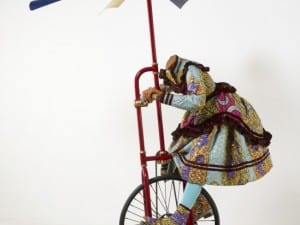As Exciting As We Can Make It: Ikon in the 1980s, currently on display at Ikon Gallery, Birmingham, is a departure from the solo and two-person exhibitions that have become synonymous with Ikon’s programme. Instead, this latest exhibition presents a culminating survey of the decade of decadence and excess. The exhibition features 29 artists that exhibited at Ikon, then located at John Bright Street, including Dennis Oppenheim, Charles Garrad, Cornelia Parker, Susan Hiller, Sean Scully, Richard Wilson and many more during the 1980s. Their works span across the two floor gallery and the tower room project space illuminating cutting edge philosophies and advancements in technologies that now look incredibly dated almost to the point of redundancy or have transitioned to become artefacts. However, as one intriguingly admires and creates rapports with these “artefacts” an astute sense of nostalgia envelops the celebration of the artists, their works and the legacies they leave behind.
Charles Garrad’s Monsoon (1986) is hidden away on the first floor in one of the gallery’s educational rooms not normally utilised to house artwork during exhibitions. A darkened room is filled by a makeshift wooden hut surrounded by an entrenchment of soil emitting a pungent and contradictory – to the space – sensory aroma. Water crashes down against the flimsy roof immediately transposing someone deep into the sweltering depths of South-Eastern Asia. In an adjacent room Garrad’s ingenious device for creating thunder – a beam attached to a rotating wheel which lets the beam drop at random against a sheet of metal – only helps to enrich this fabric of this ephemeral paradise. Inside the hut, rudimentary tables and chairs purvey the existence of inhabitants. A ceiling fan whirls hypnotically as a television monitor rests on top of a formica table, blankly displaying surges of static. On one table a solitary glass exists, on the other a lay two bowls. This strange excommunicated restaurant is given an even more disturbing veneer as the only light source, a florescent light, casts an almighty clinical artificiality over the bare skeleton of the hut.
In direct contrast to the contained yet nonetheless immersive Monsoon, the late Dennis Oppenheim’s Vibrating Forest (From the Fireworks Series) (1982) amalgamates a motley crew of materials – welded steel, a candy floss machine and unfired fireworks to create an equally devastating attack on one’s senses. The contraption overwhelms the final room on the second floor. Its presence is as bizarre as the ingredients that so freshly capture the vanguard concepts that cemented Oppenheim as a true giant in the art world. Formed of two skids with a rocking contraption with the candy floss maker attached on top pointing towards one end where a small satellite-like object fasces into the sky. Surrounding this are four right-angled sheets of metal. At the opposite end a larger satellite-like object is at these sheets of metal. Oppenheim’s widow, Amy, was at the launch of the exhibition overseeing the installation of Vibrating Forest back into the context of which it was born out of. She loving recalls that Oppenheim sourced the materials locally as it channelled the industrial heritage and importance of Birmingham as a city; an important process that he felt had to be celebrated and utilized.
One of the most iconic works to come out of Ikon during the 1980s was a commission for Cornelia Parker, Thirty Pieces of Silver (1988). The work revolved around Parker crushing over a thousand banal silver objects, including plates, spoons, candlesticks, trophies, cigarette cases, teapots and a trombone with a steam roller. These were then arranged into 30 discs comprised of the crushed silver and suspended in the gallery just above the floor allowing a physical and spatial tension to exert control. In Ikon’s Icons, located in the tower room – a small circular room with windows either side, floats one of these discs. Basking in the glow of the afternoon sunlight that streams through the windows, it floats like rare Water Lilly. The title is derived from the amount of pieces of silver Judas Iscariot was rewarded for betraying Jesus. However, as only a single disc is in the tower room, the work takes on a new integrity that feels far more sedate and reflective – the guide-ropes hanging the work become the rope in which Judas hung himself from the tree in the aftermath of his actions. Therefore the 30 pieces of silver in the narrative transform its value through context. Immediately one’s innate sense of curiosity delves deeper into the work examining the crushed silver, which now reveals a new value after the act of crushing it renders its initial value, of wealth, redundant: that of sculptural form and aesthetics.
Documentation of Susan Hiller’s installation Monument (1981), now in the collection of the Tate, harbours an opposing approach. It consists of 41 photographs of plaques on benches in Postman’s Park, London, commemorated to men, women and even a child who died while performing an act of heroism. These sculptural commemorations are transformations of value in material due to the legacies engraved upon them. The 41 photographs, one for each year Hiller had been alive at the completion of the work are presented in a diamond fashion. A bench sits in front of the photograph facing towards the photograph where to its right, a small plinth houses a television monitor and headphones showing the works installation and an overrunning commentary by Susan Hiller addressing the themes of death, memory and representation through what Hiller refers to as “cultural artefacts.” When reading the descriptions of these all-but-nameless acts of valour and accepts that they are a part of history to the viewer only, the response one conceives is of a detached paradoxical sympathy. One automatically questions what it would be like if they perished during such an action… and as an extension from this an abstract questioning reveals itself from self-inflicted wonderings – where are the people they tried to rescue and their families and loved ones now? An air of fabricated nostalgia resonates deeply. This nostalgia is at its most pure and solemn when one discovers that facing the stairs towards the entrance to the first gallery, only noticeable when leaving the gallery, a painting hangs isolated and proud. The painting is by the late David Prentice who co-founded Ikon in 1964. Yet its inclusion and its embodiment in that building with this exhibition leaves a simple and lasting message – what is will always become a was but it will always be as exciting as we can make it.
As Exciting As We Can Make It: Ikon in the 1980s, until 31 August, Ikon Gallery, 1 Oozells Square, Brindleyplace, Birmingham, B1 2HS.
William Davie
Credits
1. Dennis Oppenheim, Vibrating Forest (From the Fireworks Series) (1982). Installation, Ikon Gallery, 2014. Photo: Stuart Whipps.





